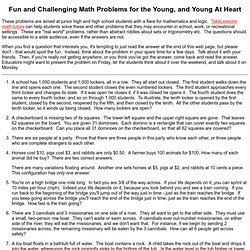

16 fun applications of the pigeonhole principle. [This article is included in the 45th Carnival of Math] Mathematical logic can produce some great trivia.

Did you know that at every instant, there is a spot in the world where no wind is blowing? It is true, and the proof comes as an application of a fixed point theorem which I discussed a year ago. This article continues the Thanksgiving tradition of discussing math trivia. These 16 fun tidbits cover topics as disconnected as birthdays, haircuts, WordPress blogs, and cocktail parties.
The pigeonhole principle The pigeonhole principle is a powerful tool used in combinatorial math. Imagine that 3 pigeons need to be placed into 2 pigeonholes. The logic can be generalized for larger numbers. The pigeonhole principle (more generalized) There is another version of the pigeonhole principle that comes in handy. Do not let the math jargon intimidate you.
Consider again the problem of stuffing pigeons into pigeonholes and consider the average. Easy (1-8) A fun card puzzle. I came across a good brain teaser at this site: A pack of cards has 52 cards.

You are in a dark room with this pack of cards. You have been told that inside the pack there are 42 cards facing down, 10 cards facing up. You have been asked to reorganize this pack of cards into two decks – so that each deck contains an equal number of cards that face up. Remember, you are in the darkness and can’t see. This seems like an impossible logic puzzle, but it turns out there is a neat answer. One hint is the two decks do not need to contain an equal number of cards. A bigger hint If you could see which cards were face up, the puzzle would be trivial. But the puzzle stipulates it’s dark and you cannot determine a card’s orientation. Even though you can’t tell if a card is face up, there is something else you can do. Thus you can move cards to the new deck and you can also choose whether to flip them. Gems of Discrete Probability. Spot the math errors! Via StumbleUpon, I came across this short text page which lists three mathematical ‘proofs’ which seem to violate common sense, listed below.
The first is: The second one is: The third one is: Each of these proofs is (intentionally) wrong! They highlight classic fallacies in mathematical thinking. (Note: the third proof involves the ‘imaginary number’ . The mistake in the first proof is highlighted in red below: The mistake lies in the assumption that we can divide by . ! The algebra ‘muddies the waters’ significantly, and it can be helpful to see the same proof, but with. Math God test. 8 really fun paper and pencil Math games » Fun Math Blog. Games and Math go really well together, although a lot of people don't make that connection.

Math really can be fun if some of its principles are taught through games. We see this in quite a number of free and commercial video games that teach math concepts, typically through solving arithmetic problems. In this article I present 8 games of a different variety. They use paper and pencil, are free, are easy to learn, and teach logical thinking and strategy that involves looking ahead. They're great fun and they can usually be played by young and old alike. After reading this list you may realize that many of the games that we typically buy we can easily make ourselves with paper, pencil, index cards, and maybe some dice. Here's my list. 1. Coordinate system. You can save yourself some money on graph paper by printing your own using the great free graph paper web-site. Wikipedia has instructions for playing battleship. Math Puzzles For Kids. These problems are aimed at junior high and high school students with a flare for mathematics and logic.

TakeLessons math tutors can help students solve these and other problems that they may encounter in school, work, or recreational settings. These are "real world" problems, rather than abstract riddles about sets or trigonometry etc. The questions should be accessible to a wide audience, even if the answers are not. When you find a question that interests you, it's tempting to just read the answer at the end of this web page, but please don't - that would spoil the fun. Instead, think about the problem in your spare time for a few days.